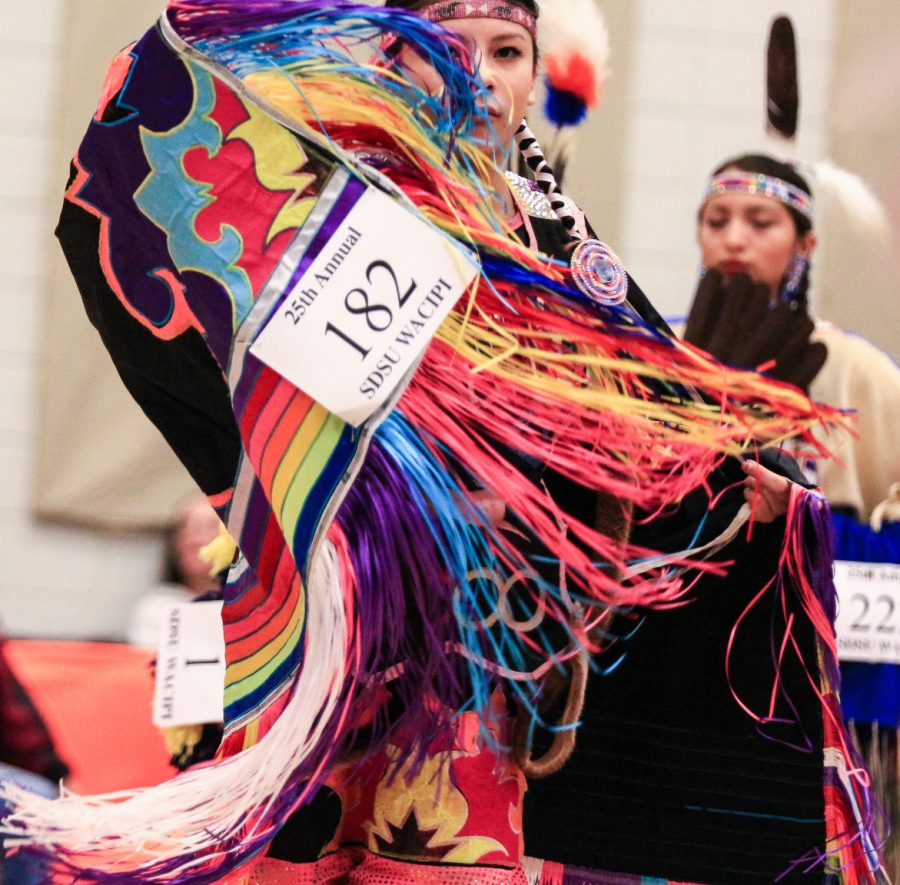Pow wow honors American Indian history
Samantha Sevier dances in her regalia at the SDSU Wacipi 2016 on Saturday, Feb. 20 in Brookings, South Dakota. This year the theme of the event is “Honoring Our Ancestor Through Education”
February 24, 2016
Children and adults alike danced to the beat of drums and sang while the bells on their regalia jingled during the 25th Annual South Dakota State University Wacipi Feb. 20.
Wacipi is another way of saying pow wow, and the event was open to everyone in the community. The event was free to students, children under 7 years old and people 65 years and older.
“It’s a celebration. You can celebrate the birth of new life, the passing of a relative, graduations, military service, wopidas (thank you) of all kinds happen at wacipis,” said April Eastman, director of the American Indian Education and Cultural Center (AIECC) and the planner of the pow wow.
There are a couple different types of pow wows: the traditional type and the competitive type. The SDSU Wacipi is a competitive event where prize money is awarded to the best singers and dancers.
“You hear people say we dance for people who can’t dance, for people in their family or in their communities, just celebrating the fact that we’re still here. I think that’s something we don’t talk about quite enough,” Eastman said. “There has to be a balance in everything. We can’t honor the good things that happen to us without honoring the bad things that have happened in our history. We are taught to acknowledge all parts of our story.”
The regalia dancers wear varies and may be specific to their family or to their tribe or region, Eastman said. Their story can be all over on their regalia, but we may not know what it is. There is a reason or story for the colors and designs.
Some of the common elements of the headdresses were porcupine quills, and common elements of the rest of the regalia were eagle feathers and bells. Some dancers donned the more contemporary neon-colored regalia while others decided to wear more neutral colors.
A crowd of about 300 people attended the event. There were 15 drums as well as 11 vendors selling primarily jewelry and other knick-knacks–even honey.
Eastman said the event was larger than what she expected. This was the first year it has been held in the Volstorff Ballroom.
“We thought the high end would be eight drums,” Eastman said.
The American Indian Student Association, Brookings Visitors Promotion Fund, SDSU Diversity Office and the AIECC provided financial support and Tiospaye council members gave some donations for the Elderly room, but as far as planning goes, Eastman did the majority of it with assistance from the AIECC secretary, Lila Grebner.
“It’s a lot of responsibility to plan an event of that magnitude, and not one that we want our students to carry,” Eastman said. “Our students are showing more interest in exploring leadership development opportunities, both on and off campus.”
Ideally, Eastman said, there would be multiple entities involved in the planning of such a large event, and often times people want to help but they don’t know how or don’t know who to contact. They had several non-Native volunteers from Ruth Harper’s counseling and human resource development class.
“We had amazing head staff [announcer, arena director, head judges] that guided us when we had questions during the planning stages and the day of the wacipi,” Eastman said.
Throughout the event, there were several kinds of dances: the intertribal dance, men’s traditional dance, men’s fancy dance, men’s grass dance, women’s traditional dance, women’s fancy dance, jingle dress dance and other special dances. There was also an informal dinner at 5 p.m., which was included with the cost of admission.
“That’s typical with tribal events that you provide a meal,” Eastman said.
The pow wow has the potential to be more than a celebration for students.
“It’s an opportunity to learn and see,” Eastman said. “There is so much more than just dancing that happens at a wacipi.”
For Marisa Hare, treasurer of the American Indian Student Services (AISS), this was her first year helping with the wacipi.
Part of her role in the wacipi was to carry the flags in the grand entry, run the AISS booth, talk to alumni and participate in the honoring for the administration and retirees.
“I like how it is about coming together as a community to dance and talk with everyone, see how they’re doing and enjoy their company,” Hare said.
Sherri Hall, a senior history major with a minor in American Indian studies, has been a long time attendee of the event.
“I’ve gone to a few wacipis in the past and I love them. I try to make it whenever I can. They’re fun events to come to, just to sit and watch the dances,” Hall said.
Although the event is open to everyone and the AIECC attempts to promote inclusiveness, Eastman said a lot of students don’t think they can attend. This year, even though it was held in the Student Union, there weren’t as many students in attendance as she had hoped.
“Hopefully we’ll get to a place where we’ll see more than just a handful of non-Native students going to the event,” Eastman said.
























